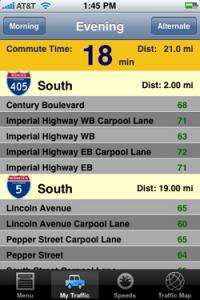New iPhone Traffic App Delivers Personalized Traffic Reports to California Commuters

(PhysOrg.com) -- Motorists in California equipped with the Apple iPhone can now get personalized traffic information via the "California Traffic Report," the first iPhone application from the University of California, San Diego division of the California Institute for Telecommunications and Information Technology (Calit2). In the first ten days since the app became available through Apple’s App Store on Feb. 7, roughly 2,650 people have downloaded the application, and downloads continue to run at a clip of roughly 250 per day.
Another sign of its popularity: the California Traffic Report made it into the first page of “Top Free” apps in the Travel section of the App Store.
To download the free app, consumers can search the App Store from their iPhones for the title “California Traffic Report,” or scroll through the Travel category. The direct App Store link is here. This link requires that iTunes be installed on the user’s computer. If iTunes is not installed, consumers can view the app here.
The application is built on top of a 5-year-old, voice- and web-based service created and operated by engineers at Calit2 as a community service.
“There are other traffic apps available for the iPhone, but none of them offers personalized reports like we do,” said Ganz Chockalingam, a principal development engineer at Calit2. “Most are traffic cameras, or traffic overlays like the ones at Google Maps. But our California Traffic Report is getting many 5-star reviews in the App Store because of the usefulness of having customized data at your fingertips.”
The California Traffic Report covers most highways in southern California - in Los Angeles, Orange, Riverside, San Bernardino and San Diego counties - as well as San Francisco, San Jose and other Bay Area cities.
The traffic app delivers commute times based on current traffic conditions, traffic speeds and congestions, and traffic maps based on data supplied by Caltrans. Users can track specific sections of highway, but to benefit from personalized features, they must register online at traffic.calit2.net, and input their morning and afternoon commutes, as well as any alternative routes. Based on that information, the iPhone app provides quick access to daily commuting times.
Other features on the website but not yet available on the iPhone app include daily traffic reports and alerts via email or text messaging, and graphs that calculate the best time to commute based on recent speeds for the motorist’s specific route.
Chockalingam and programmer Sam Fernald did not start out planning to create an app for the iPhone. “We began to write a Java application for other phones but it became cumbersome because of the wide variety of phone interfaces,” said Chockalingam.
Fernald has worked part-time at Calit2 since 2006 while finishing his undergraduate degree in bioengineering/biotechnology in UCSD’s Jacobs School of Engineering. After graduating last June, Fernald began working on the iPhone app. “To develop for the iPhone, I needed a Mac with an Intel chip, and we had to sign a non-disclosure agreement with Apple under which we also agreed to give Apple complete access to the app’s code,” said Fernald. “But in the end, the iPhone turned out to be the perfect device for this type of application. The touch interface and large screen make it easier to use the application than a Java application on other cell phones.”
The iPhone app also makes it easier to access information than using the voice-based features of the California Traffic Report in its original incarnation as a toll-free phone service.
“The big difference between the voice-based service and the iPhone app is that with a voice service, everything is serial, and you have to respond to each question at a time,” said Chockalingam. “The iPhone interface allows for very fast and efficient retrieval, and you can see a map of your route or alternative routes, which you don’t get with a voice-only service. You can quickly focus in on the area you want.”
Creating the app, however, was not easy. “We tested and debugged the application on the iTouch and the emulator that comes with the iPhone software development kit,” said Fernald. “We put off testing on the iPhone itself until the very end.”
In time, the Calit2 engineers intend to expand the number of features on the California Traffic Report app for the iPhone. New features will include the ability to upload and listen to peer-to-peer recordings about current traffic conditions as witnessed by other motorists - a popular feature on the version of the traffic report that can be accessed via a voice interface. Version 2.0 of the California Traffic Report will also take advantage of the iPhone’s built-in GPS functionality. “You’ll be able to take photos of traffic jams or accidents, and they can be automatically uploaded and tagged with the exact time and location,” said Fernald.
Fernald had a background programming in C, but he had to teach himself Objective C - the programming language for the Mac operating system and the iPhone. “Apple developers clearly have a leg up when it comes to programming apps for the iPhone,” said Fernald.
Having developed the California Traffic Report, Fernald now hopes to use that experience to work on other iPhone apps, including development of a video game. He and Chockalingam are in discussions with other groups within Calit2 and across the UC San Diego campus to provide iPhone app design services on a contract basis. Resarch groups on and off campus who are interested in iPhone development for a project should contact Ganz Chockalingam at ganz (at) ucsd.edu.
Provided by UC San Diego





















